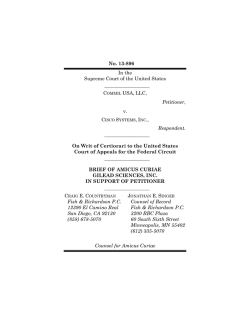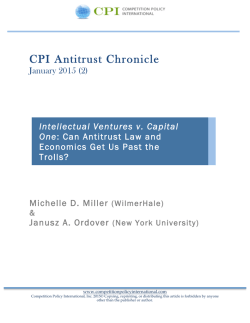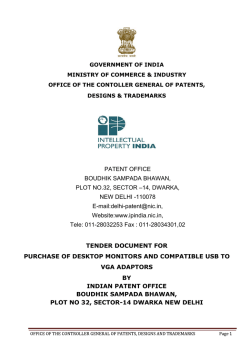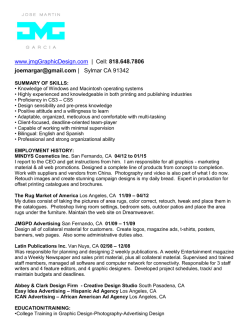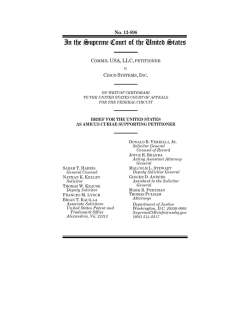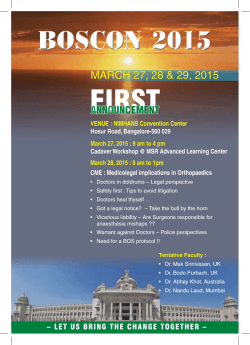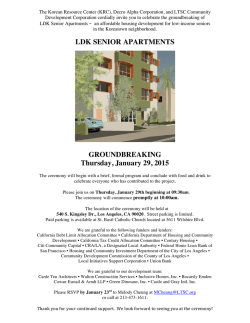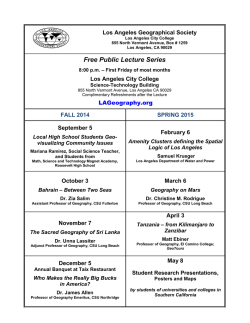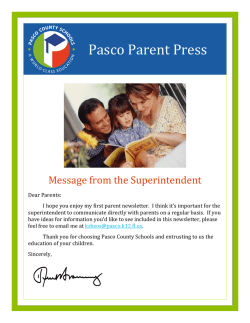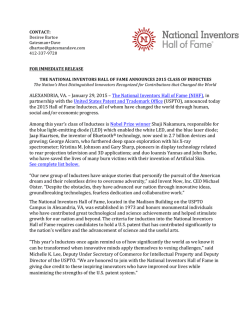
WRL2015Feb - Laipla.net
Wegner Red Letter A Monthly Newsletter Looking to What’s Next in Patent Law February 2015 ▲▲▲▲▲▲▲▲▲▲▲▲▲▲▲▲▲▲▲▲▲▲▲▲▲▲▲▲▲ People in the News: Charles Earnest Grassley (R-Iowa) Rep. Darrell Issa (R.-Cal.) Michelle K. Lee Professor Christal Sheppard 2 Patent Legislation in the 114th Congress 3 Supreme Court Merits Cases (dec. by June 2015) Commil v. Cisco -- § 271(b) Scienter Kimble v. Marvel – Post-Expiration Royalties 4 Supreme Court Pending Petitions Bristol-Myers v. Teva – Papesch Nonobviousness Google v. Vederi, Claim Construction (CVSG Outstanding) Packard v. Lee –§ 112(b) Nautilus Definiteness STC.UNM v. Intel, Indispensible Party for Patent Lawsuit Madstad v. Patent Office – First to File Constitutionality ZOLL Lifecor – Right to Challenge Denial of IPR Post-Grant Review Consumer Watchdog v. WARF – Post-Grant Appellate Standing Gilead v. Natco – Double Patenting 6 Unique Petition HIMPP , World Record Longest Predicate to “Questions Presented”? 15 At the Federal Circuit Suprema v. ITC – Induced Infringement at the ITC Early Patent History – Germany 15 About the Wegner Red Letter 16 ▲▲▲▲▲▲▲▲▲▲▲▲▲▲▲▲▲▲▲▲▲▲▲▲▲▲▲▲▲ Wegner Red Letter is the sole work product of Harold C. Wegner and may be cited as “Wegner Red Letter” [Month, Year], Los Angeles Intellectual Property Law Association, available at www.laipla.net/category/wegners-writings. Correspondence address: [email protected] 1 Wegner Red Letter A Monthly Newsletter Looking to What’s Next in Patent Law February 2015 ▲▲▲▲▲▲▲▲▲▲▲▲▲▲▲▲▲▲▲▲▲▲▲▲▲▲▲▲▲ People in the News: Charles Earnest Grassley (R-Iowa): Chuck Grassley is the new Chairman of the Senate Judiciary Committee. Unlike previous leadership of this committee, Senator Grassley is not a lawyer but someone who has followed the patent system, particularly the Federal Circuit. Rep. Darrell Issa (R.-Cal.) is the new subcommittee chair within the House Judiciary Committee in charge of patents. Representative Issa is not a lawyer but has a deep knowledge of the patent system from the perspective of a very successful inventor. Quite independent of patents, Rep. Issa has long had a deep interest in government spending and waste; he can be expected to cast a critical eye on Patent Office expenditures. Michelle K. Lee has now gone through a hearing in the Senate on the road to her confirmation as Under Secretary of Commerce to run the Patent Office. She still needs a Senate Judiciary Committee vote and then, if favorable, a full vote of the Senate. The timing of such events is largely due to circumstances having little if anything to do with the qualifications of the candidate. Professor Christal Sheppard is the new Director of the Detroit Office of the U.S. Patent and Trademark Office. Dr. Sheppard is the first high ranking leader in the history of the American patent system to hold advanced degrees in biotechnology. Prior to entering the academy she had been a patent attorney with Foley & Lardner in its Washington, D.C., and thereafter held positions in government including a key staff position in the House of Representatives. Prof. Sheppard is widely respected and admired within patent circles who would be a popular choice for the position of Deputy Under Secretary, once the incumbent is confirmed to the Position of Under Secretary. ▲▲▲▲▲▲▲▲▲▲▲▲▲▲▲▲▲▲▲▲▲▲▲▲▲▲▲▲▲ Wegner Red Letter is the sole work product of Harold C. Wegner and may be cited as “Wegner Red Letter” [Month, Year], Los Angeles Intellectual Property Law Association, available at www.laipla.net/category/wegners-writings. Correspondence address: [email protected] 2 Wegner Red Letter A Monthly Newsletter Looking to What’s Next in Patent Law February 2015 ▲▲▲▲▲▲▲▲▲▲▲▲▲▲▲▲▲▲▲▲▲▲▲▲▲▲▲▲▲ Patent Legislation in the Current 114th Congress (2015-2016): It is premature to predict enactment of any patent legislation in the current Congress. In the United States there are roughly 600 or so bills that are introduced in each two year Congress; only about ten percent of the bills are passed into law. Most of the bills that do become law receive final votes in Congress in the very last weeks of the two year session. At any time in the session, amendments are made to legislation that can make major changes. Therefore, it is premature to make any prediction as to enactment of patent legislation in this Congress. At this early date, however, there are two areas of legislation that deserve close attention: (a) New Definition of Patent-Eligibility: There is a serious movement to modify the definition of patent-eligibility under 35 USC § 101 to erase the exception of the Alice case. Will legislation to deal with Alice be passed in the current Congress? This is a very difficult and iffy question. While there are clearly supporters of the result that would be achieved by such legislation there are also many who would oppose softening the standard of patenteligibility for software innovations. ▲▲▲▲▲▲▲▲▲▲▲▲▲▲▲▲▲▲▲▲▲▲▲▲▲▲▲▲▲ Wegner Red Letter is the sole work product of Harold C. Wegner and may be cited as “Wegner Red Letter” [Month, Year], Los Angeles Intellectual Property Law Association, available at www.laipla.net/category/wegners-writings. Correspondence address: [email protected] 3 Wegner Red Letter A Monthly Newsletter Looking to What’s Next in Patent Law February 2015 ▲▲▲▲▲▲▲▲▲▲▲▲▲▲▲▲▲▲▲▲▲▲▲▲▲▲▲▲▲ (b) “Loser Pays” “Patent Reform” Legislation: Certain to be introduced again in this Congress is “loser pays” legislation largely following the previous bills. The last Congress saw the death of this legislation through the procedural veto of Harry Reid, leader of the (Democratic) Senate majority. The Congress is now under control of the Republic Party ending the Reid veto. Over the course of the past fifty-plus years patent issues have had a largely bipartisan flavor. One major exception has been the area of “loser pays” legislation because this is part of a more macroscopic concern as to litigation generally – having nothing to do with patents. In this one area, the Democratic Party has been very strongly supported by proponents of the current system that denies a “loser pays” system. Will “loser pays” legislation pass the Senate? It is far too early to say. Procedural rules in the Senate are tricky so that Senate passage cannot be taken for granted. Supreme Court Merits Cases Commil v. Cisco -- § 271(b) Scienter: In Commil USA, LLC v. Cisco Sys., Inc. Supreme Court No. 13-896, merits argument is expected late in the current Term; a decision is expected by June 2015. Petitioner challenges the new Federal Circuit standard of scienter for active inducement under 35 USC § 271(b) that belief that a patent is invalid is basis to avoid a charge of active inducement to infringe the patent. ▲▲▲▲▲▲▲▲▲▲▲▲▲▲▲▲▲▲▲▲▲▲▲▲▲▲▲▲▲ Wegner Red Letter is the sole work product of Harold C. Wegner and may be cited as “Wegner Red Letter” [Month, Year], Los Angeles Intellectual Property Law Association, available at www.laipla.net/category/wegners-writings. Correspondence address: [email protected] 4 Wegner Red Letter A Monthly Newsletter Looking to What’s Next in Patent Law February 2015 ▲▲▲▲▲▲▲▲▲▲▲▲▲▲▲▲▲▲▲▲▲▲▲▲▲▲▲▲▲ First Question Presented: “Whether the Federal Circuit erred in holding that a defendant’s belief that a patent is invalid is a defense to induced infringement under 35 U.S.C. § 271(b).” Kimble v. Marvel – Post-Expiration Royalties: In Kimble v. Marvel Enterprises, Inc., Supreme Court No. 13-720, opinion below, 727 F.3d 856 (9th Cir. 2013) (Callahan, J.), petitioner challenges the rule of Brulotte v. Thys Co., 379 U.S. 29 (1964), that a patentee’s use of a royalty agreement that projects payments beyond the expiration date of the patent is unlawful per se. Question Presented: “* * * [B]ecause royalty payments under the parties’ contract extended undiminished beyond the expiration date of the assigned patent, Respondent’s obligation to pay was excused under Brulotte v. Thys Co., 379 U.S. 29, 32 (1964), which had held that ‘a patentee’s use of a royalty agreement that projects beyond the expiration date of the patent is unlawful per se.’ “A product of a bygone era, Brulotte is the most widely criticized of this Court’s intellectual property and competition law decisions. Three panels of the courts of appeals (including the panel below), the Justice Department, the Federal Trade Commission, and virtually every treatise and article in the field have called on this Court to reconsider Brulotte, and to replace its rigid per se prohibition on postexpiration patent royalties with a contextualized rule of reason analysis. “The question presented is: “Whether this Court should overrule Brulotte v. Thys Co., 379 U.S. 29 (1964).” ▲▲▲▲▲▲▲▲▲▲▲▲▲▲▲▲▲▲▲▲▲▲▲▲▲▲▲▲▲ Wegner Red Letter is the sole work product of Harold C. Wegner and may be cited as “Wegner Red Letter” [Month, Year], Los Angeles Intellectual Property Law Association, available at www.laipla.net/category/wegners-writings. Correspondence address: [email protected] 5 Wegner Red Letter A Monthly Newsletter Looking to What’s Next in Patent Law February 2015 ▲▲▲▲▲▲▲▲▲▲▲▲▲▲▲▲▲▲▲▲▲▲▲▲▲▲▲▲▲ Supreme Court Petitions: Bristol-Myers v. Teva – Papesch Pharmaceutical Nonobviousness: BristolMyers Squibb Co. v. Teva Pharms. USA, Inc., Supreme Court no. 14-886, proceedings below, 769 F.3d 1339 (Fed. Cir. 2014)(Order den. reh’g en banc), panel opinion, 752 F.3d 967 (Fed. Cir. 2014)(Chen, J.), would – if certiorari is granted – open the door to Supreme Court consideration for the first time the more than fifty year old precedent of In re Papesch, 315 F.2d 381 (CCPA 1963), to measure nonobviousness of a claimed compound as a whole instead of looking merely to structural similarities. The positive value of a Supreme Court reversal of the Federal Circuit is obvious as a stimulus to pharmaceutical research; but, an affirmance could spell disaster on the same order of magnitude as what Alice has done for software technology. Question Presented: “The [ ] Federal Circuit invalidated a patent claim on a lifesaving new compound as obvious over the combination of two toxic prior art compounds. In doing so, the court relied on an erroneous understanding of the prior art’s properties that existed at the time the patent application was filed and reused to consider post-filing evidence demonstrating stark differences between the patented compound and the toxic prior art. “The question presented is: “Should courts consider post-filing evidence showing the actual differences between a patented invention and the prior art?” ▲▲▲▲▲▲▲▲▲▲▲▲▲▲▲▲▲▲▲▲▲▲▲▲▲▲▲▲▲ Wegner Red Letter is the sole work product of Harold C. Wegner and may be cited as “Wegner Red Letter” [Month, Year], Los Angeles Intellectual Property Law Association, available at www.laipla.net/category/wegners-writings. Correspondence address: [email protected] 6 Wegner Red Letter A Monthly Newsletter Looking to What’s Next in Patent Law February 2015 ▲▲▲▲▲▲▲▲▲▲▲▲▲▲▲▲▲▲▲▲▲▲▲▲▲▲▲▲▲ Opening a Can of Patent Worms: Under Papesch, the pharmaceutical industry for more than fifty years has expended huge sums of money for regulatory approval of new drugs which are “structurally obvious” but have superior and unexpected properties. Upsetting the Papesch patent applecart would have hugely negative consequences for pioneer pharmaceutical research. Why Wasn’t a CIP Filed to Focus on the Difference in Properties? Among the issues not specifically considered by the Federal Circuit is In re Kirchner, 305 F.2d 897 (CCPA 1962)(Rich, J.), that permits Papesch consideration of an undisclosed property if a continuation-in-part is filed adding that property, because the continuation-in-part is entitled to the original filing date. Cf. Carter-Wallace, Inc. v. Otte, 474 F.2d 529, 540-41 (2nd Cir. 1972)(discussing Kirchner); Mendenhall v. Cedarapids, Inc., 5 F.3d 1557, 1565 (Fed. Cir. 1993)(Nies, J.)(characterizing Kirchner as standing for the proposition that a “chemical property [is] sufficient for utility to support later claim to chemical compound where no claim was made to compound's use[.]”)(original emphasis); Kennecott Corp. v. Kyocera International, Inc., 835 F.2d 1419, 1422-23 (Fed. Cir. 1987)(Newman, J.)(analyzing Kirchner); Eli Lilly & Co. v. Premo Pharmaceutical Laboratories, Inc., 630 F.2d 120, 134 n.64 (3rd Cir. 1980)(discussing In re Davies, 475 F.2d 667, 672 (CCPA 1973), where the Patent Office refused to consider previously undisclosed unexpected properties of a claimed compound, but citing Kirchner, authorized refiling of application to incorporate such properties). ▲▲▲▲▲▲▲▲▲▲▲▲▲▲▲▲▲▲▲▲▲▲▲▲▲▲▲▲▲ Wegner Red Letter is the sole work product of Harold C. Wegner and may be cited as “Wegner Red Letter” [Month, Year], Los Angeles Intellectual Property Law Association, available at www.laipla.net/category/wegners-writings. Correspondence address: [email protected] 7 Wegner Red Letter A Monthly Newsletter Looking to What’s Next in Patent Law February 2015 ▲▲▲▲▲▲▲▲▲▲▲▲▲▲▲▲▲▲▲▲▲▲▲▲▲▲▲▲▲ Google v. Vederi, Claim Construction (CVSG Outstanding): In Google, Inc. v. Vederi, Supreme Court No. 14-448, opinion below, Vederi, LLC v. Google, Inc., 744 F.3d 1376 (Fed. Cir. 2014)(Rader, C.J.), petitioner questions the Federal Circuit standard of claim construction keyed to “disavowal” of scope. At some point this year the Solicitor General will file a brief explaining the Government’s position whether certiorari should be granted responsive to a CVSG order on January 12, 2015. There is little chance for an early CVSG brief. (There is no time limit as to when the brief must be filed.) Question Presented: “When an applicant for patent amends a claim to overcome the Patent and Trademark Office’s earlier disallowance of the claim, should a court (i) presume that the amendment narrowed the claim and strictly construe the amended claim language against the applicant, as this Court has held, or (ii) presume that the claim scope remained the same and require that any narrowing be clear and unmistakable, as the Federal Circuit has held?” Packard v. Lee –§ 112(b) Nautilus Definiteness: In Packard v. Lee, Supreme Court No. 14-655, opinion below, In re Packard, 751 F.3d 1307 (Fed. Cir. 2014)(per curiam), a decision whether to grant certiorari is expected this Spring. Merits argument would take place in the October 2015 Term running to June 2016. Petitioner challenges a new examination regime for indefiniteness under 35 USC § 112(b). ▲▲▲▲▲▲▲▲▲▲▲▲▲▲▲▲▲▲▲▲▲▲▲▲▲▲▲▲▲ Wegner Red Letter is the sole work product of Harold C. Wegner and may be cited as “Wegner Red Letter” [Month, Year], Los Angeles Intellectual Property Law Association, available at www.laipla.net/category/wegners-writings. Correspondence address: [email protected] 8 Wegner Red Letter A Monthly Newsletter Looking to What’s Next in Patent Law February 2015 ▲▲▲▲▲▲▲▲▲▲▲▲▲▲▲▲▲▲▲▲▲▲▲▲▲▲▲▲▲ Questions Presented: “1. Can the Federal Circuit affirm an administrative agency decision on a novel procedural ground that the agency did not consider? “2. Can the United States Patent and Trademark Office use a standard that this Court expressly rejected in Nautilus, Inc. v. Biosig Instruments, Inc., 134 S. Ct. 2120 (2014), to decide whether patent claims violate the definiteness requirement of 35 U.S.C. § 112(b)?” STC.UNM v. Intel, Indispensible Party for Patent Lawsuit: In STC.UNM v. Intel Corp., Supreme Court No. 14-717, prior proceedings, 767 F.3d 1351 (Fed. Cir. 2014)(Order)(per curiam), panel opinion, 754 F.3d 940 (Fed. Cir. 2014), the appellate tribunal denied en banc consideration of the panel’s ruling that precludes a patent owner from using Rule 19 to join an indispensable party, effectively denying the right to enforce the patent. A decision whether to grant certiorari is expected in March or April; if granted, merits arguments would take place in the October 2015 Term running until June 2016. Question Presented: “Rule 19 of the Federal Rules of Civil Procedure provides that where a necessary party to a lawsuit has not been joined, ‘the court must order that the person be made a party.’ The Court of Appeals for the Federal Circuit ruled below that Rule 19 is ‘trumped’ by a purported ‘substantive rule’ that a coowner of a patent can ‘impede an infringement suit brought by another co-owner.’ The majority opinion below stands in stark contrast to this Court's precedents. For over seventy years, this Court has rejected every statutory challenge to a Federal Rule that has come before it. “The question presented is: ▲▲▲▲▲▲▲▲▲▲▲▲▲▲▲▲▲▲▲▲▲▲▲▲▲▲▲▲▲ Wegner Red Letter is the sole work product of Harold C. Wegner and may be cited as “Wegner Red Letter” [Month, Year], Los Angeles Intellectual Property Law Association, available at www.laipla.net/category/wegners-writings. Correspondence address: [email protected] 9 Wegner Red Letter A Monthly Newsletter Looking to What’s Next in Patent Law February 2015 ▲▲▲▲▲▲▲▲▲▲▲▲▲▲▲▲▲▲▲▲▲▲▲▲▲▲▲▲▲ “Whether Rule 19 of the Federal Rules of Civil Procedure applies in patent infringement cases or is trumped by a substantive right of a patent co-owner to bar a fellow owner's infringement suit.” Madstad v. Patent Office – First to File Constitutionality: In Madstad Eng'g, Inc. v. United States PTO, Supreme Court No. 14-366, opinion below, 756 F.3d 1366 (Fed. Cir. 2014)(O’Malley, J.), a decision whether to grant certiorari is expecte on February 20th. Petitioner challenges the Leahy Smith America Invents Act of 2011 as unconstitutional insofar as the first-to-file provision is concerned. Questions Presented: “1. Whether the Federal Circuit's decision that Petitioners lack standing to challenge the ‘First-Inventor-to-File’ provisions of the America Invents Act [AIA] conflicts with precedent of this Court and decisions in other circuits. “2. Whether the ‘First-Inventor-to-File’ provisions of the AIA are unconstitutional under the Intellectual Property Clause of Article I, Section 8, Clause 8.” ZOLL Lifecor – Right to Challenge Denial of IPR Post-Grant Review: In ZOLL Lifecor Corp. v. Philips Elecs. N. Am. Corp., Supreme Court No. 14-619, opinion below, 577 Fed. Appx. 991 (Fed. Cir. 2014)(Order)(O’Malley, J.), a Conference is expected by March; if granted, the merits argument would take place in the October 2015 Term running until June 2016. Petitioner-IPR patent challenger argues the Federal Circuit has jurisdiction to hear an appeal from denial of a petition to institute Inter Partes Review (as opposed to the unquestioned statutory right to appeal a merits decision in an IPR review). ▲▲▲▲▲▲▲▲▲▲▲▲▲▲▲▲▲▲▲▲▲▲▲▲▲▲▲▲▲ Wegner Red Letter is the sole work product of Harold C. Wegner and may be cited as “Wegner Red Letter” [Month, Year], Los Angeles Intellectual Property Law Association, available at www.laipla.net/category/wegners-writings. Correspondence address: [email protected] 10 Wegner Red Letter A Monthly Newsletter Looking to What’s Next in Patent Law February 2015 ▲▲▲▲▲▲▲▲▲▲▲▲▲▲▲▲▲▲▲▲▲▲▲▲▲▲▲▲▲ Question Presented: “Sections 312, 314, and 315 of Title 35 each identify separate requirements for instituting an administrative inter partes review (IPR) proceeding to invalidate a patent that the [USPTO] erroneously issued. The only one of these three sections that limits an IPR petitioner's right to appeal is Section 314, and it is limited on its face to decisions ‘under this section.’ A general right to appeal is provided by 28 U.S.C. § 1295(a)(4)(A), which grants the Federal Circuit ‘exclusive jurisdiction...of an appeal from a decision of-the Patent Trial and Appeal Board [PTAB] of the [USPTO] with respect to a[n] ... inter partes review under Title 35.’ Despite this statutory structure and plain statutory language, the Federal Circuit has repeatedly refused to review dismissals of IPR proceedings made under Sections 312 and 315 (which are not the sections under which Congress said there could be no appeal). The Federal Circuit ‘s holdings leave IPR petitioners dismissed under these sections with no appellate review, and give the USPTO essentially unfettered discretion to dispose of petitions alleging that the agency erred in granting a patent. “The question presented is: “Whether the Federal Circuit has erred in blocking all appellate review of USPTO decisions made under 35 U.S.C. §§ 312 and 315, when the only limit in the statute is in Section 314, which is expressly limited to decisions made ‘under this section’ – thus giving the USPTO complete and unreviewable authority under these two sections to reject assertions that the agency previously erred in granting patents.” ▲▲▲▲▲▲▲▲▲▲▲▲▲▲▲▲▲▲▲▲▲▲▲▲▲▲▲▲▲ Wegner Red Letter is the sole work product of Harold C. Wegner and may be cited as “Wegner Red Letter” [Month, Year], Los Angeles Intellectual Property Law Association, available at www.laipla.net/category/wegners-writings. Correspondence address: [email protected] 11 Wegner Red Letter A Monthly Newsletter Looking to What’s Next in Patent Law February 2015 ▲▲▲▲▲▲▲▲▲▲▲▲▲▲▲▲▲▲▲▲▲▲▲▲▲▲▲▲▲ Consumer Watchdog v. WARF – Post-Grant Appellate Standing: In Consumer Watchdog v. Wisconsin Alumni Research Foundation, Supreme Court No. 14-516, proceedings below, 753 F.3d 1258 (Fed. Cir. 2014)(Rader, J.), a certiorari decision is expected February 23rd. Patent challenger-petitioner challenges the appellate court’s dismissal of its patentability challenge on the basis of lack of standing. Question Presented: “Does a statute that expressly provides a requester of agency action a right to appeal any dissatisfactory decision of the agency on her request to the courts provide sufficient Article III standing for the appeal, or must additional requirements be satisfied above and beyond the statute? Gilead v. Natco – Double Patenting In Gilead Sciences, Inc. v. Natco Pharma Ltd., Supreme Court No. 14-647, opinion below, 753 F.3d 1208 (Fed. Cir. 2014)(Chen, J.), a majority has once again judicially expanded the scope of double patenting to invalidate a patent. A certiorari decision is expected in March or April. Question Presented: “This Court's double-patenting doctrine establishes the ‘wellsettled rule that two valid patents for the same invention,’ or obvious modifications of that invention, ‘cannot be granted’ to a single party. Miller v. Eagle Mfg. Co., 151 U.S. 186, 196-97 (1894). The Court has repeatedly held that when two such patents are granted to a single party, ‘the later one [i]s void.’ Id. at 197 (discussing Suffolk Co. v. Hayden, 70 U.S. (3 Wall.) 315 (1865)). In the decision below, the Federal Circuit inverted this century-old doctrine, holding a first-issued patent invalid based on the issuance of the second patent. “The question presented is: ▲▲▲▲▲▲▲▲▲▲▲▲▲▲▲▲▲▲▲▲▲▲▲▲▲▲▲▲▲ Wegner Red Letter is the sole work product of Harold C. Wegner and may be cited as “Wegner Red Letter” [Month, Year], Los Angeles Intellectual Property Law Association, available at www.laipla.net/category/wegners-writings. Correspondence address: [email protected] 12 Wegner Red Letter A Monthly Newsletter Looking to What’s Next in Patent Law February 2015 ▲▲▲▲▲▲▲▲▲▲▲▲▲▲▲▲▲▲▲▲▲▲▲▲▲▲▲▲▲ “Whether, contrary to this Court's consistent and longstanding precedent and Congress's intent, the double-patenting doctrine can be used to invalidate a properly issued patent before its statutory term has expired using a second, laterissuing patent whose term of exclusivity is entirely subsumed within that first patent's term?” Unique Petition HIMPP , World Record Longest Predicate to “Questions Presented”? February 23rd is the likely certiorari decision date in K/S HIMPP v. Hear-Wear Technologies, LLC, Supreme Court No. 14-744, proceedings below,751 F.3d 1362 (Fed. Cir. 2014)(Lourie, J.). Petitioner-patent challenger has presented Questions Presented that, if granted, may have the longest predicate of any patent case ever before the Court on the merits: Questions Presented: “The PTO during an inter partes reexamination of U.S. Patent No. 7,016,512 confirmed two dependent claims in a hearing-aid patent that recited a multipronged plug at the end of an insulated wire connecting two known portions of the hearing-aid even though there was no dispute that such multipronged plugs were known in the art for half a century. Yet the Federal Circuit in a precedential 2-1 decision affirmed the result solely because the Petitioner's original inter partes reexamination request did not support that notorious fact with documentary evidence. The majority affirmed in the face of an ex parte reexamination of the same patent that reached a contrary result, in the face of record prior art showing that exact feature, and even in the face of an admission at oral argument that multipronged plugs were known in the art. The Federal Circuit's affirmance is contrary to the Administrative Procedures Act requiring whole record review, and contrary to this Court's landmark obviousness decision in KSR Int'l Co. v. Teleflex, 550 U.S. 398 (2007). ▲▲▲▲▲▲▲▲▲▲▲▲▲▲▲▲▲▲▲▲▲▲▲▲▲▲▲▲▲ Wegner Red Letter is the sole work product of Harold C. Wegner and may be cited as “Wegner Red Letter” [Month, Year], Los Angeles Intellectual Property Law Association, available at www.laipla.net/category/wegners-writings. Correspondence address: [email protected] 13 Wegner Red Letter A Monthly Newsletter Looking to What’s Next in Patent Law February 2015 ▲▲▲▲▲▲▲▲▲▲▲▲▲▲▲▲▲▲▲▲▲▲▲▲▲▲▲▲▲ “The APA requires courts reviewing an agency decision under the substantialevidence standard to consider the whole record of the formal agency proceedings. 5 U.S.C. § 706 (2012). What comprises the entire record of a patent in an administrative proceeding at the PTO has not been addressed by the Court. This novel legal question is important. It is not uncommon for the PTO to review a single claim over the course of several proceedings. Here the Federal Circuit ignored the factual findings of a Petitioner-initiated parallel ex parte review of the same patent claims, by the same three examiners, that reached a contrary result. It also ignored record evidence that the patent owner itself later presented in the inter partes reexamination that detracted from the PTO's decision. “This Court's obviousness jurisprudence requires an expansive approach. It was set forth most recently in KSR, 550 U.S. at 415, where this Court broadly warned against a rigid approach to determining obviousness and against an overemphasis on printed publications. Yet here, the Federal Circuit created a bright-line rule that demands documentary evidence for every structural feature of a claim, no matter how trivial or notoriously well-known. The new rule effectively precludes examiners from relying on common sense/common knowledge to find a structural feature in the prior art. “The Questions Presented are: “1. Did the Federal Circuit misapprehend and grossly misapply the APA's doctrine of whole record review when it refused to consider submitted prior art and all the PTO's prior patentability determinations of the disputed claims under review? “2. Did the Federal Circuit err when it created a new, bright-line rule that precludes the use of common knowledge or common sense to find obvious claimed structural elements, no matter how trivial or notoriously well-known?” ▲▲▲▲▲▲▲▲▲▲▲▲▲▲▲▲▲▲▲▲▲▲▲▲▲▲▲▲▲ Wegner Red Letter is the sole work product of Harold C. Wegner and may be cited as “Wegner Red Letter” [Month, Year], Los Angeles Intellectual Property Law Association, available at www.laipla.net/category/wegners-writings. Correspondence address: [email protected] 14 Wegner Red Letter A Monthly Newsletter Looking to What’s Next in Patent Law February 2015 ▲▲▲▲▲▲▲▲▲▲▲▲▲▲▲▲▲▲▲▲▲▲▲▲▲▲▲▲▲ At the Federal Circuit Suprema v. ITC – Induced Infringement at the ITC: Awaiting decision following February 5th en banc argument is a decision where the Federal Circuit granted two petitions for en banc review raising a total of five different questions for en banc review in Suprema, Inc. v. ITC, __ Fed. App’x __(Fed. Cir. 2014)(unpublished Order), vacating panel opinion, 742 F.3d 1350 (Fed. Cir. 2013)(O’Malley, J.). In a nutshell, does the importation of a noninfringing component of a patented combination provide basis for an ITC exclusion order where there is infringement by customers in the United States who practice the patented combination? Early Patent History The notes in this section are based upon the author’s book, PATENT HARMONIZATION (London: Sweet & Maxwell 1993). Germany: Long prior to both the implementation of the Paris Convention and the creation of modern Germany patents had been granted under patent laws of various Länder, including Bavaria (1812) and Prussia (1815). See PATENT HARMONIZATION § 181, The German System, pp. 15-16. Early American counterpart patents of German patents include patents litigated in Cochrane v. Badische Anilin & Soda Fabrik, 111 U.S. 293 (1884); and considered in Imhaueser v. Buerk, 11 Otto (101 U.S.) 647 (1880); and Powder Co. v. Powder Works, 8 Otto (98 U.S.) 126 (1878); Atlantic Giant Powder Co. v. Dittmar Powder Mfg. Co., 1 F. 328, 339-40 (S.D.N.Y. 1880); see also O'Reilly v. Morse, 15 How. (56 U.S.) 62, 108 (1854) (citing as prior art early work of Dr. Steinhiel of Munich who communicated his discovery to the Academy of Science in Paris in 1838). ▲▲▲▲▲▲▲▲▲▲▲▲▲▲▲▲▲▲▲▲▲▲▲▲▲▲▲▲▲ Wegner Red Letter is the sole work product of Harold C. Wegner and may be cited as “Wegner Red Letter” [Month, Year], Los Angeles Intellectual Property Law Association, available at www.laipla.net/category/wegners-writings. Correspondence address: [email protected] 15 Wegner Red Letter A Monthly Newsletter Looking to What’s Next in Patent Law February 2015 ▲▲▲▲▲▲▲▲▲▲▲▲▲▲▲▲▲▲▲▲▲▲▲▲▲▲▲▲▲ About the Wegner Red Letter The Wegner Red Letter continues a thirty-five year tradition of newsletter information to colleagues about patent developments that started on June 16, 1080, with a G II fax transmission to colleagues in Europe and Asia about that the decision that day in Diamond v. Chakrabarty, 447 U.S. 921 (1980), and until the end of January 2015 had evolved into a series of usually daily emails to “The List”. The Wegner Red Letter returns to the original roots of this information service to provide colleagues in Europe and Asia with a comparative focus on American patent developments. The goal is to provide a more in depth view of American patent developments. While the writer’s daily email service no longer exists, particularly important developments will be shared through the Los Angeles Intellectual Property Law Association on their website under “Wegner’s Writings”, www.laipla.net/category/wegners-writings/ The need for prompt information for American colleagues is now more than satisfied by several reliable website resources particularly information from Professors Dennis Crouch and Jason Rantanen on Patently O, www.patentlyO.com, scientist-lawyers Dr. Donald Zuhn and Dr. Kevin Noonan who write on PatentDocs, www.patentdocs.org, and pharmaceutical patent expert Courtenay Brinckerhoff’s PharmaPatents Blog, www.pharmapatentsblog.com, and litigator Justin Gray’s Gray on Claims, www.grayonclaims.com. Supreme Court information including a rich collection of briefs is found on the website of Supreme Court advocate Tom Goldstein’s ScotusBlog, www.scotusblog.com. *** The Wegner Red Letter is authored by Professor Hal Wegner. Correspondence relating to this newsletter is to [email protected], while information concerning his practice as an independent Expert Consultant is at [email protected] ▲▲▲▲▲▲▲▲▲▲▲▲▲▲▲▲▲▲▲▲▲▲▲▲▲▲▲▲▲ Wegner Red Letter is the sole work product of Harold C. Wegner and may be cited as “Wegner Red Letter” [Month, Year], Los Angeles Intellectual Property Law Association, available at www.laipla.net/category/wegners-writings. Correspondence address: [email protected] 16
© Copyright 2024
